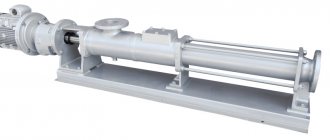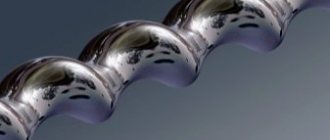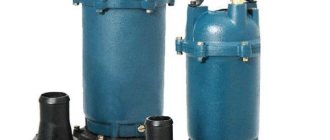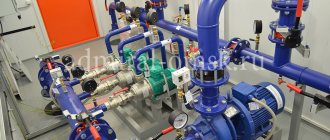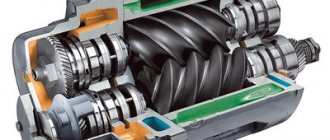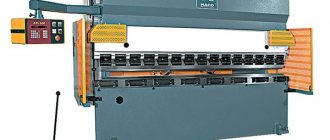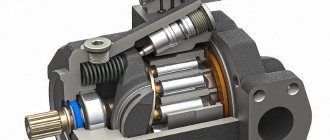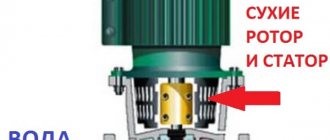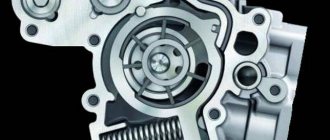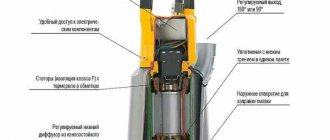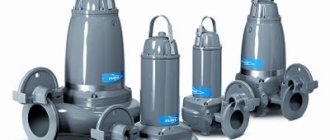Scope of application of the screw
At its core, a screw is a solid rod with a solid helical surface located along the longitudinal axis. The auger owes its origin to the great scientist Archimedes, who invented a water-lifting machine, which was called the Archimedes screw.
Before using the screw pump, you must carefully study the instructions.
Nowadays, screws are used everywhere and in a wide variety of industries:
- A meat grinder is one of the simplest and most common devices using an auger;
- Screw conveyors;
- Screw pumps;
- All-terrain vehicle - ShN-1 auger;
- Drilling mechanisms;
- Ice fishing enthusiasts use an auger to drill a hole in the river ice;
- The auger principle is used in drills to remove chips during operation;
- Used in small arms in auger magazines;
- Widely used in presses;
- Often used in combines for various purposes.
The operating principle of the auger is so simple that it can be used everywhere, and examples can be given endlessly. Needless to say, even in science fiction works there are machines that use screw mechanisms. For example, miracle machines that drill through the thickness of mountains or pierce almost right through the bowels of planets.
Design and principle of operation
Screw rotors rotating inside the stator displace liquid, increasing its pressure. The liquid is pumped by moving it between the screw grooves located along the axis of the screw and the housing. To improve the quality of the design and reduce the number of leaks, conical and cylindrical elastic casings are used. The spring presses the conical screw quite reliably, and the fluid, due to the pressurized pressure, helps reduce the number of leaks. If it is necessary to withstand heavy loads, metal cases are used instead of elastic ones.
The most commonly used pump is the three-screw pump. Its advantages:
- The substance is supplied evenly;
- It is possible to suck out the liquid;
- The ability to pump liquid with solid additives without causing damage;
- The noise level is quite low;
- The balancing of the mechanism is quite good;
- Unlike other types, in a three-screw there is no need to use multistage to obtain the desired pressure at the outlet of the device.
Thanks to their compact size, screw pumps do not take up much space
However, the device also has disadvantages. The cost of such a pump is quite high due to the complexity of its manufacture, it is not possible to regulate the working volume, and idle operation is unacceptable.
Screw pump design - what does the device consist of?
The main element of a screw pump is the rotor. It has a cylindrical shape and a spiral groove resembling a screw or auger. The rotor is located inside a stator equipped with an elastomeric sleeve and a spiral channel. The stator itself has the shape of a steel pipe. The rotary spiral can be equipped with several passes. In this case, the stator spiral is always equipped with one more entry.
Along the contact line between the stator and the rotor there are areas protected from water penetration, dividing the working cavity of the pump into several parts. Due to the special arrangement of the rotor in the stator, these sections alternately open and close.
The volume of pumped liquid is adjusted by changing the number of rotor revolutions. To do this, use a frequency drive.
All pump elements are housed in a durable plastic or cast iron housing. Moreover, if a screw pump is used for a well, its body is made of stainless steel.
DIY making
At all times, there have been craftsmen who prefer to do everything themselves and trust only those things that they made with their own hands. Screw devices are no exception.
A homemade concrete pump or water pump is a fairly common occurrence.
Regardless of how the thing was made - with your own hands or in a specialized production facility, the manufacturing technology is not much different, and it must be. It is unlikely that it will be possible to make a screw pump on a whim.
Therefore, before making a screw pump, you should know how to do it:
- Since creating a concrete pump is a rather expensive and complex process, you should be one hundred percent sure that making it yourself will be more expedient than buying or renting a ready-made model.
- Like any complex technical mechanism, it should be manufactured according to a pre-drawn drawing. You can find a ready-made drawing or design it yourself if you have the appropriate skills.
- The key element in a concrete pump is the working cylinder with a piston. You should not take a cylinder larger than 400 mm with a piston stroke of no more than 0.5 m.
- In order for the device to serve effectively and for a long time, parts should be manufactured with high precision and low roughness.
- When choosing, you should remember that a hydraulic pump will be much more expensive and more difficult to manufacture than an electric pump.
- The correct choice of gearbox is one of the key manufacturing procedures.
To assemble a screw pump with your own hands, you need to have relevant experience.
For the manufacture of check valves, alloy steel should be used. Also, do not forget about using a king pin.
Recommendations for choosing a pump for a well
Among the various types of pumping equipment used for pumping water from a well or well, submersible devices are the most popular. This popularity is explained by a number of advantages of submersible pumps, which include:
- no noise during operation;
- the ability to ensure uninterrupted water supply from a serviced well;
- ease of installation;
- the ability to provide water supply from wells of considerable depth;
- compact dimensions;
- no need for additional cooling of the drive motor;
- anti-corrosion properties of the materials from which the body is made.
When choosing such a device, you should pay attention to such parameters as:
- the total demand of water intake points for water, which the selected pump must provide;
- characteristics of the well from which water is to be pumped (diameter and depth);
- geological data of the area where the well was drilled (depth at which groundwater is located, soil type, etc.);
- the presence of a power source at the site where it is planned to install pumping equipment.
The main technical characteristics by which pumping equipment is selected are:
- the performance of the device, which characterizes how much liquid it is capable of pumping per unit of time;
- pressure (this parameter, measured in meters of water column, indicates to what height and distance the pump is capable of transporting liquid through the pipeline system).
This approach when choosing pumping equipment will give you the opportunity to further modernize your pumping station if the need arises.
Installing deep-well pumps, as a rule, does not cause any particular difficulties; it can be done even without experience in carrying out such procedures. When operating submersible pumps, as well as any other type of pumping equipment, one should not forget about their regular maintenance, which will significantly extend the life of their trouble-free use.
Submersible screw pump for water
Owners of private houses are often faced with the desire or need to acquire their own source of water. To do this, a well is drilled and a submersible pump is installed. There are two types of pumps for these purposes: vibration and screw, also known as screw. The vibrating one is several times cheaper, but due to its design features and operating mode, it destroys the well and is quite noisy during operation. In contrast, the auger is quiet in operation, does not destroy the well, but is expensive to purchase or manufacture.
Read also: Corrugated sheet 3mm weight 1 m2
When choosing a pump, you should proceed from your own requirements and characteristics of the device:
- Capacity is selected based on the amount of water required for use. The device should not operate idle.
- Power is directly related to performance, and is also selected taking into account the maximum load on the electrical network allowed in a particular home.
- Water pressure at the final point of analysis.
- Dynamic water level in a source relative to ground level.
- The difference in height between the point of collection at the source and the point of collection at the consumer.
- Do not forget about the loss of pressure in the system, especially in horizontal sections.
The housing material depends on the operating environment. When used for a home well, use stainless steel or plastic. Weight and method of fastening are two criteria dependent on each other.
Submersible pumps are used not only at home, but also on an industrial scale for extracting or pumping water from wells of various depths.
When immersed in the pumped medium, borehole pumps take up liquid and give it the necessary pressure to rise through pipes to the surface from a great depth. The peculiarities of their design make it possible to use them not only for raising water - pumping equipment of this type copes with pumping viscous liquids. They are widely used in the chemical, food, oil and gas industries and in everyday life. Most dynamic deep-well pumps are damaged by the presence of sand in liquids, but screw units work with dirty water without breakdowns.
Review of models from various manufacturers
When choosing equipment for a well, pay attention not only to the technical characteristics, but also to the brand. After all, most models of domestic and Chinese products are not distinguished by high quality and reliability. Although there are some good budget models among them.
Watch a video about Aquarius products:
An example is the Volodya screw well pump. It belongs to submersible type units and is used before supplying water from both open reservoirs and wells, as well as wells. However, with the latter it can only be used if their internal diameter is at least 10 cm.
The equipment of this brand is compact and this with quite high power. It is attached to the well using a synthetic cable supplied with the pump. It does an excellent job of providing water to a private home, as well as irrigation systems.
The unit is easy to operate, easy to dismantle and can even be used for pumping alkali and acids.
Belamos models
Another popular model of screw equipment is produced under the Belamos brand. These submersible screw pumps are designed for supplying water from wells and mine wells and are classified as deep-well models.
They are quite powerful and are able to provide all the necessary water needs of residents. The body of the device is made of stainless steel. The unit is equipped with reliable thermal protection, which allows the engine to operate flawlessly for a long time without stopping.
But still, pumps from foreign manufacturers are considered the best. One of the most optimal is the unit under the Unipump ECO VINT brand. It is capable of providing good pressure, has low productivity and compact dimensions.
Watch a video about the Unipump ECO VINT model:
There is no vibration when the equipment operates, which allows you to avoid mechanical impurities getting into the water supply, as well as to avoid destructive effects on the filtration cone. Using this model in your own home allows you to organize a complete water supply system.
Cost of screw pumps
Equipment for organizing an autonomous water supply system in a country house has quite high prices. But of course they are different for each modification. Thus, the most primitive units, such as the domestically produced screw pump for wells Malysh, have a price of only 2 thousand rubles, but they are also designed for operation for one season.
If you want your water supply system to work for a long period without breakdowns, then it is better to choose, albeit expensive, foreign models. The cheapest of them will cost around $200, but will last at least 10-15 years.
Consumer Reviews
Owners of screw pumps who have been able to evaluate all their capabilities note that they have several features that determine their wide popularity. This is primarily a convenient design. Such equipment is very easy to operate, and repair work can be performed directly in the field.
You can also read in the reviews that repairing pumps does not require complete disassembly, for example, when replacing a bearing from a drive shaft. In addition, this does not require any special equipment. And all repair work can be completed quite quickly, since simple dismantling is ensured by the presence of self-clamping couplings in the unit.
Let's watch the video, practical advice from a specialist on choosing:
One of the most frequently mentioned advantages in user reviews is the lack of vibration. It is thanks to him that screw pumps have a long service life, which has led to their great popularity.
Conclusion
What requirements must a pump for a home well meet? Most often, it is required to be able to pump water containing many mechanical impurities. After all, if a well is made in sandy soil, then the liquid coming from it may contain it. When using a vibration pump in this case, the space around the filter is compacted, therefore, the well flow rate is reduced.
While the use of a screw unit will save you from the possibility of such consequences of operation. They can work with fluid contaminated with sand up to 20 kg/m³ and are considered the best option for wells that are heavily sandy.
Related posts:
- How good is the Grundfos fecal pump?
- We choose wisely the fecal pump for the dacha
- Criteria for choosing a fecal pump with a grinder
- We clean the well with a drainage pump
- Criteria for choosing a submersible pump for dirty water
Principle of operation
The equipment maintains a constant flow - in contrast to the pulsating rhythm of the pumped medium in centrifugal versions of the equipment - this characteristic is important for working at great depths. Features of operation and structural components of self-priming volumetric pumps using the principle of a multi-stage structure:
- The design provides one vertical shaft, this helps reduce the transverse dimensions to a minimum. Because of the resulting configuration, pumps are used in wells and Abyssinian wells.
- As a container for the pumped liquid, a pump casing is used, made for use in well conditions from high-quality metal, since polymers cannot withstand the created loads.
- The movement of the liquid is ensured by the action of a screw screw (rotor), during the rotation of which the liquid is taken from the well, accelerated, pressure is given to it and then it moves through the hose.
- The rotor is powered by an electric motor and is driven through a rigid shaft. The stability of the installation is ensured with the help of a bearing set and other components that are selected by the designers depending on the class of the unit.
- The rotor is a steel screw (single-thread auger) of circular cross-section, which has a wide thread pitch. The stator is represented in the design with the same cross-section, but its thread pitch is twice as large. By rotating inside the stator, the rotor captures water from the suction pipe and directs it to the outlet passage.
- The quality of the pump depends on the complexity of the internal structure; the higher the indicator, the longer the service life is due to the minimization of wear on the drives and screw.
- In transmission pumps, unlike submersible ones, the motor is located on the surface, next to the water intake well, and is connected to the pumping device by an intermediate shaft. Such units are capable of lifting oil from depth to the surface from a depth of 125-130 m with a supply of 1200 m³ per hour.
- For transmission devices, the pump part consists of several cast iron sections connected by studs. Each chamber contains a working centrifugal wheel and a shaft, all sections fit into one mesh that allows water to pass through.
- Several working sections allow you to set the required pressure and regulate it, while the unit interacts with the pressure pipeline through a flange located on the upper body of the section. The transmission is located inside a protective pipe containing oil. The sections are assembled gradually, increasing their number as they enter the well.
Submersible pump designs feature a rigid connection between the motor and shaft, so there is no need to use a transmission shaft, which helps to simplify the design. Submersible units are successfully installed in crooked shafts, and the working building for equipment above the wellhead is smaller in volume. Submersible pumps have a longer service life compared to other options, since vibration is significantly reduced due to their reliable design.
Submersible pumps have positive characteristics, but they also have disadvantages. Depending on the type of equipment installed, their performance indicators and service life vary.
With submersible motor (EVN)
This design underlies the use of single-screw hydration machines in the oil industry and is an effective means of artificial lift for high-viscosity oil. In some embodiments, the use of such equipment is the only applicable option. The submersible pumping unit includes the following components and spare parts:
- electric motor filled with oil;
- water protection system;
- a pump including a graphite axial foot, a drive stuffing box, two pairs with screw threads in different directions, rotors connected to each other and by means of articulated couplings with the drive shaft.
The pump kit additionally includes a valve with a specified set of functions that protects against pressure fluctuations and the reverse flow of water through the RO in the event of an unexpected stop; an overrunning clutch is provided. The flow of the withdrawn liquid is carried out in the opposite direction through the RO channels, which leads to balancing of the axial forces in the lower and upper pairs.
The flows are mixed in the pressure chamber and enter the tubing through the gap between the housing and the stator, in this case the axial pump support is unloaded, and the reliability of the equipment increases. Using EWH pumps, high-viscosity oil containing mechanical debris (up to 0.8 g/l) and gas (up to 50%) is extracted from the subsoil at the receiving stage. The serial production includes about 13 standard sizes of pumps , providing a pressure of 9-16 MPa and a daily flow of 15-200 m3.
Read also: Absolute tensile strain
Design innovations to increase reliability and service life include reducing the speed of the drive shaft; for this, an adjustable electric drive and gear inserts are used. The general layout of the unit, the location of individual parts and assemblies, and the simplification of repair and maintenance conditions are changing.
Rod type (VShNU)
The start of operation for oil extraction from great depths began in the 80s in America and France, since then the design of the installations has been improved many times, many standard sizes have been created with a flow range from 0.5 to 1 thousand m3 per day, the pressure has averaged 30 MPa.
These pumps have advantages compared to other types of equipment, for example, they are distinguished from pumping machines by:
- simple design, small weight and dimensions, simple periodic maintenance and management;
- no need to build a load-bearing base or foundation;
- reducing the cost of transporting equipment;
- successful work with liquids having different viscosity and gas formation;
- no rollback of RO, constant loads on the rods;
- uniformity of fluid flow;
- reduction of energy costs and engine power.
They differ from the operation of pumps with submersible electric drive:
- ease of assembly of starting couplings, axial and radial bearings, absence of movable joints on hinges;
- the ground device of the engine makes the water protection device unnecessary and simplifies monitoring the technical condition of the unit;
- Due to the above-ground installation of the engine, it becomes possible to work with low-cost wells, since there is no need to organize additional heat removal from the engine.
VShNU equipment is operated in wells with a pressure from 1 thousand to 1 thousand 500 m³ with high-viscosity media with a fifty percent gas content in the composition. The downhole unit consists of a stationary column, at the bottom of which a stator, a stop pin, a counter-turn armature, a filter and a gas separator are attached. In the column cavity there is a rotating rod connected at the bottom to the pump rotor. The main components of VSHNU pumps are the following parts:
- drive head;
- a tee is used to drain fluid;
- frame for securing the engine;
- rotational motion transmission;
- adjustable drive motor;
- device for positioning the polished rod.
The pump moves the formation fluid in the gap between the columns and rods, and then discharges it through the side pipe into the reservoir. Rod pumps are produced in pipe and plug-in versions; units of the second type are gaining popularity, allowing the pump to be disconnected for maintenance or repair without lifting it to the surface.
Hydraulic driven (GPNA)
These units operate on the principle of reciprocating piston movement , in connection with this the machines have a number of advantages:
- there is no rod or cable connection between the energy source and the pump;
- work successfully in small-diameter wells located at an angle;
- allow you to regulate the feed of the submersible device, smooth start, and maintain the desired intensity of oil extraction;
- simplify equipment maintenance without lifting and lowering.
As hydraulic motors, which are slightly modified, a PDM with a diameter of 86−109 mm and a rotation speed of 100−350 revolutions is used, the fluid flow rate is 4−11 l/s, the pressure is in the range of 6−8 MPa. Pumping screw multi-pass pairs are used as RO, this allows you to develop a wide variety of received liquids with an intake range from 6 to 110 m³ per day. With an optimal pair length of 1.5−2.0 m, the unit develops a pressure of 10−15 MPa.
The ground part, similar to GPPU pumps, includes a plunger power pump, a liquid preparation device (for separating emulsions, separators, settling tanks), control devices and equipment for arranging the mouth of the lifting slot. Hydraulic screw pumps have advantages that distinguish them from hydraulic piston versions:
- ease of assembly and operation due to the absence of spool valves and valves;
- the use of technical water as a working fluid, eliminating the complex cleaning process;
- work with viscous oil and increased gas content;
- there are no hydraulic and dynamic loads due to the absence of reverse movement of the working bodies.
A comparison with sucker rod pumps shows the following advantages:
- operated in crooked wells with a significant bore slope;
- there is no rod equipment;
- the ground power pump regulates technological modes by changing the supply intensity;
- you can change the submersible unit and carry out repairs in convenient conditions.
What distinguishes them from working with electric submersible devices is:
- there is no need to connect the electrical cable and protect it from moisture;
- the starting properties of the unit have been improved.
Oil twin-screw (NDPN)
The unit is designed to work in wells with low funding for work. It contains an electric-type submersible motor, a protector, a compensator, protection from ambient moisture, a check and drain valve, expansion pipes, a transformer and a cable. To increase the pressure, a composite version of several modules is used.
To ensure the passage of viscous liquids, various options for manufacturing the flow part are provided, which differ in the gaps between the body and the working screws. In this regard, before selecting a pump and installing it, the required clearance parameters are calculated.
Selection and maintenance of screw technology
To choose the screw technology that is best suited for the needs of your production, it is worth considering some design features. To decide which device to choose, you should first determine the type of device you need, on which the productivity indicator in cubic meters per hour or liters per minute will depend.
Then determine the required pressure level and height of the liquid column in the area of the pipe, the so-called NPSN indicator. In addition, it is necessary to take into account the chemical composition, density and viscosity, temperature and acid-base balance of the pumped substances. In addition, take into account the amount of abrasives and the possible presence of solid particles in the pumped material.
Three-screw pump design
Well, don’t forget to take into account the voltage and frequency of the power supply network, and the type of transmission mechanism from the motor to the pump. The repair kit included in the equipment list with the most necessary spare parts will be of considerable help.
A screw pump repair kit usually consists of a replacement working screw and a rubber gasket. Therefore, when the auger wears out, you can replace it yourself without having to contact the service department.
Areas of use
Screw technology is used in many areas of industrial production and for domestic needs. Among the main types of screw-type pressure equipment are:
Detailed diagram of a screw pump
- screw pump for water (various variations of a centrifugal pump - vacuum electric pumps, pneumatic screw pump, deep submersible pump);
- food screw pump (milk, oil and fat, confectionery and others);
- devices for the pharmaceutical and chemical industries;
- equipment for the oil and gas and petrochemical industries;
- equipment for power plants;
- equipment for the marine and shipbuilding industry.
An increased level of chemical and mechanical resistance to various non-abrasive inclusions and viscous elements that may be present in the liquid is determined by the elastomeric composition of the stator housing. In addition, it is the composition of the stator housing that determines the maximum permissible temperature range with which screw technology can operate.
For example, in the oil industry, housings are made from NBR elastomer, which can withstand temperatures up to 80 °C. In screw technology for general industrial use, EPDM and HYPALON materials are used, which are able to operate at temperatures up to 120 °C. And in the chemical industry they use FKM type rubber elastomer, which can withstand temperatures up to 150 °C.
Domestic use
Screw submersible pumps have been used for extracting water from private wells for a long time. With their help, they reduce water contamination. If gas development is underway, the units are used to dehydrate the natural resource. Screw-type submersible devices are used to extract warm water from deep subsoil to create alternative heating; pumps of this type easily relieve the well owner of various mechanical impurities in the water without breaking down. The use of this particular type of equipment is predetermined by the following indicators:
- pumps operate quietly, which distinguishes them from vibration equipment or centrifugal units;
- the equipment shows a high efficiency;
- the water structure is preserved, unlike centrifugal equipment;
- only one moving part in the design increases the service life in domestic conditions.
Read also: Converting a computer power supply to 12 volts
In autonomous water supply systems, as well as in the operation of systems for pumping various liquids, various types of pumping equipment are used. For wells and wells in the private sector, I most often use submersible models, which also include a screw pump for a well. This type of equipment is widely used not only in everyday life, but also in industry due to its simple and practically trouble-free design.
Well installation rules
To immerse an electric screw pump into a well, use a head or adapter, to which a cable is tied and a water supply pipeline coming from the unit is attached. Usually, before diving, the pressure hose, power supply cable and holding cable are tied together with insulating tape or plastic ties, and the following rules are observed during installation:
- Water-lifting pipes can be selected from low-pressure polyethylene (HDPE), steel or flexible elastic polymers, the main condition is the ability to withstand the maximum pressure in the system and the internal bore diameter is not lower than the thread size inside the outlet pipe.
- When using a flexible hose, make sure there are no kinks or twists.
- For lowering and lifting, use only a nylon or metal (stainless) cable; it is forbidden to hang the unit by the electrical cable.
- Before diving, you should make sure that the internal diameter of the casing is higher than the external dimensions of the pump housing together with the electrical cable, and that the pipes do not have any bends or narrowed areas.
- It is not recommended to place the power cable in a coiled coil - this leads to overheating and melting of the insulation.
- The minimum distance of the pump from the bottom of the well is 0.5 meters, the optimal is 1 m.
- It is prohibited to operate the pump with the tap closed - this will lead to its failure.
- It is mandatory to install a dry-running protective relay in the control system, even if there is internal automatic protection against winding overheating.
- When installing modifications that do not have a built-in check valve, it is installed on the outlet pipe in front of the water-lifting pipeline.
Rice.
10 Installation and connection diagram for a screw unit When comparing which well pump is better: centrifugal or screw, there is no clear answer, since the scope of application of these pumping units is slightly different. Screw electric pumps are usually used in situations where it is necessary to work with contaminated water, and due to their relatively low technical characteristics, the well should have a shallow depth or be located closer to an individual house. It is impossible to find European-made screw pumps on the domestic market; all goods are supplied to the retail chain by domestic and Chinese companies, so user reviews regarding the quality and materials of manufacture of screw units are contradictory.
Design Features
Screw pumps, also called screw pumps, operate using a simple mechanism based on a rotating screw (screw) located inside a cylindrical or cone-shaped housing. The supply and movement of liquid inside the working chamber occurs due to the constant movement of the screw. During the continuous movement of the auger, grooves on its surface force the liquid to move only forward, preventing it from flowing back. Thus, submersible screw pumps maintain a constant water pressure in the system without increasing the operating pressure in the chamber.
Rice. 1 Screw pump device
Features of the functioning of screw models of pumping equipment involve their immersion directly into the working environment - into a well or well. This is explained by the fact that such a design of the equipment does not allow it to work on the so-called. Idling. For stable operation of the unit, a constant fluid level is needed, and without access to the working medium, the equipment simply stops.
How best to use
When purchasing a screw pump for an equipped source, you will have to take into account certain operating rules. By following simple recommendations, the homeowner will be able to significantly extend the life of the device. To operate a screw pump in a well, it is advisable to select a pump that can be well mounted on the wall of the shaft. It is advisable to install the device at an optimal depth so that the likelihood of the water level dropping to a critical level is minimal. This will prevent the device from running dry.
It is advisable to maintain a distance of at least 1 meter from the bottom so that liquid mixed with sand is not pumped through the water supply. When purchasing a screw unit, you don’t have to worry about the reliability of the operation of such equipment. The design of the product and the basic principle of operation were specially developed in such a way that the water intake hole was located above the engine itself. The working unit, thanks to this design, can be cooled naturally. The probability of fire in this case is practically zero.
Features of water intake are decisive in the selection of functional characteristics of equipment. Before selecting a suitable pump, be sure to take into account all the required control parameters.
You may also like
Choosing a submersible pump for a well
Water pumps for wells - popular models
Advantages and disadvantages of technology
A screw well pump (or centrifugal, as it is also called) is considered one of the preferred types of pumping equipment for supplying water to an autonomous water supply system, as well as in production for pumping and circulating various liquids - petroleum products, liquefied gas, aggressive working environments with a high content of chemicals reagents.
The main advantages of submersible screw pumps are:
- high performance;
- ease of maintenance;
- no noise during operation;
- ability to work with working environments of varying quality.
The last point is one of the most important for many users of pumping equipment. While other models are quite sensitive to the composition of the working medium and can fail even with a small inclusion of sand in the water, screw pumps are insensitive to water contamination and can work even with heavily contaminated and even viscous media. This is one of the most critical parameters for many well owners, where even coarse filters cannot cope.
Disadvantages of screw pumps
This equipment has a number of disadvantages, which you also need to know about before choosing screw models:
- high price;
- fixed working volume;
- inability to work “idle”.
When choosing screw type dirty water pumps, the user must be prepared to pay a higher amount to the seller compared to other standard types of equipment. The average cost of one model, depending on the manufacturer, is several hundred dollars for imported equipment. You can also take domestic models, for example “Malysh”, “Vodomet”, “Belamos” and others. But the market leaders both in Russia and abroad are foreign brands such as Grundfos, Gadrena, Aquatica, Werk and others.
Scope of application
A submersible pump for wells can be used in various fields of activity for the following purposes:
- The function of water intake and movement of the extracted liquid through the pipeline;
- Filling various containers equipped on site with liquid;
- Watering all kinds of plant crops;
- Water intake from a conventional well.
The depth of the source from which water intake is planned must be taken into account when selecting a screw pump. There is a possibility of rising liquid with a high concentration of sand in a situation where its depth is approximately 1-2 meters. The design features of screw pumps make it possible to interact with water containing impurities.
Equipment classification
All screw pumps for wells are divided into standard and deep. The former are suitable for installation in shallow wells and boreholes, for example, for extracting water from sandy aquifers. Such models have lower productivity and are usually installed at a depth of no more than 20-25 meters. The deep well pump has a longer body and auger and is intended for installation in artesian wells, the drilling of which reaches several hundred meters in depth. Such models are characterized by greater productivity and, accordingly, a higher price.
When answering the question of which screw-type pump to choose for a well, it is necessary to take into account the parameters of the hydraulic structure. The depth of the water surface, as well as the facility’s need for water supply, are the main technical factors influencing the choice of unit. You should also take into account the power of the equipment itself, because it will require a constant power supply to operate.
Deep and standard screw electric pumps consume an average of 1.5 kW of energy per hour, which will allow them to be connected to a standard 220V power source. But manufacturers recommend selecting a separate source of electricity for pumping equipment and additionally protecting it with a circuit breaker.
“>
Advantages of screw pumps
- The screw water pump does an excellent job of pumping solid particles without damaging the mechanisms of the device.
- The device is incredibly compact, which allows it to be used in various conditions.
- The pump weighs relatively little, so it is possible to carry it without any extra effort.
- Screw pumps for wells can be suspended on a cable, which makes it easier to operate in certain situations.
- The device works effectively in both vertical and horizontal positions.
- The pump can operate for a long time without interruption.
- The powerful mechanism of screw pumps for wells copes well even with thick silty mixtures. The unit is easy to maintain and repair.
- The pump does not create excess noise even with intense operation, and there is no vibration, which significantly extends the service life of the device.
